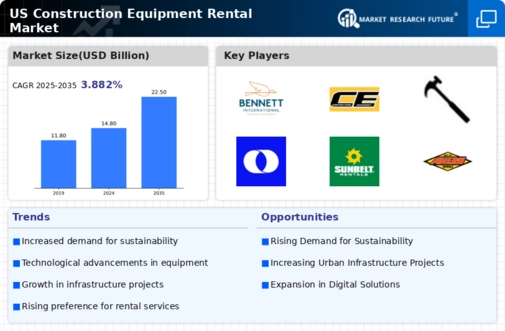Rising Infrastructure Investments
The construction equipment-rental market is experiencing a surge due to increased investments in infrastructure across the United States. Government initiatives, such as the Infrastructure Investment and Jobs Act, have allocated substantial funding for roads, bridges, and public transit systems. This influx of capital is likely to drive demand for rental equipment, as contractors seek to minimize upfront costs while maximizing operational efficiency. In 2025, the construction sector is projected to grow by approximately 5%, further bolstering the rental market. As projects expand, the need for diverse equipment, from excavators to cranes, becomes essential, positioning rental services as a viable solution for contractors aiming to meet project deadlines without the burden of ownership costs.
Urbanization and Population Growth
Urbanization trends in the United States are contributing significantly to the construction equipment-rental market. As more individuals migrate to urban areas, the demand for residential and commercial construction rises. This trend necessitates the use of various construction equipment, which rental companies can provide efficiently. The U.S. Census Bureau indicates that urban areas are expected to grow by 13% by 2030, leading to increased construction activities. Consequently, rental services become an attractive option for builders who require specialized equipment for short-term projects. The flexibility of rental agreements allows contractors to adapt to fluctuating project demands, thereby enhancing their operational capabilities in a rapidly changing urban landscape.
Cost Efficiency and Budget Constraints
In the current economic climate, many construction firms are facing budget constraints, prompting a shift towards the construction equipment-rental market. Renting equipment allows companies to avoid the high capital expenditure associated with purchasing machinery, which can be particularly burdensome for small to medium-sized enterprises. According to industry reports, rental costs can be up to 30% lower than ownership costs when considering maintenance, storage, and depreciation. This financial advantage encourages contractors to opt for rental solutions, especially for projects with uncertain timelines. As firms strive to maintain profitability while managing costs, the rental market is likely to see sustained growth, driven by the need for cost-effective solutions in construction.
Environmental Regulations and Compliance
The construction equipment-rental market is increasingly influenced by stringent environmental regulations in the United States. As sustainability becomes a priority, construction firms are compelled to adopt eco-friendly practices, including the use of low-emission equipment. Rental companies that offer compliant machinery are likely to gain a competitive edge, as contractors seek to align with regulatory standards while minimizing their environmental footprint. The Environmental Protection Agency (EPA) has set ambitious targets for reducing emissions, which may drive demand for rental services that provide greener alternatives. This shift not only supports compliance but also appeals to clients who prioritize sustainability, thereby expanding the market for environmentally responsible rental solutions.
Technological Integration in Rental Services
The integration of advanced technologies in the construction equipment-rental market is reshaping how rental companies operate. Innovations such as telematics, GPS tracking, and mobile applications enhance equipment management and monitoring, providing real-time data to users. This technological advancement not only improves operational efficiency but also increases safety on job sites. As contractors become more tech-savvy, they are likely to prefer rental services that offer these modern solutions. The adoption of technology in rental operations can lead to a projected increase in market share, as companies that leverage these tools can better meet customer demands and streamline their services. This trend indicates a shift towards a more data-driven approach in the rental market.


















Leave a Comment